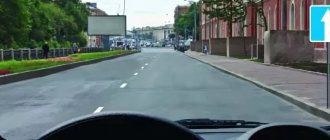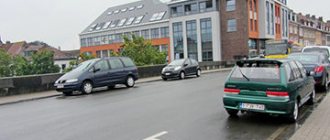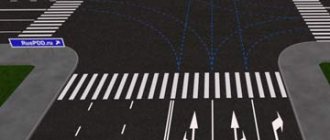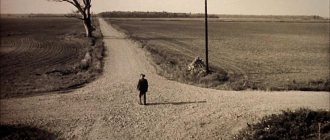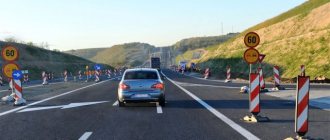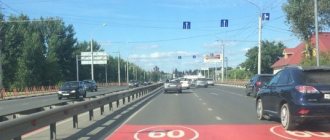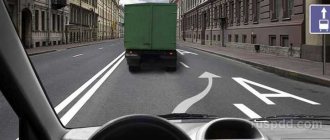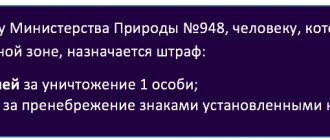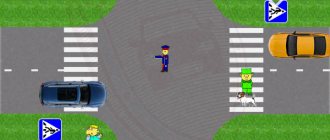What is reversing according to traffic regulations?
Oddly enough, in the Traffic Rules you will not find an exact definition of the concept of “reversing”. But there are maneuver characteristics.
Reversing is the movement of a vehicle in the direction opposite to the main flow of traffic. Except perhaps when leaving a parking lot or garage. There are different maneuvers used there.
Paragraph 8.12 of the traffic rules is devoted to reversing traffic:
Reversing a vehicle is permitted provided that this maneuver is safe and does not interfere with other road users. If necessary, the driver must seek the help of others.
Thus, the maneuver is quite risky and difficult. To avoid getting into an accident or hitting a pedestrian, you need to carefully consider your next steps. And be sure to take into account traffic regulations. They indicate on which sections of the road you cannot drive in reverse.
Rules for driving in reverse
Now let’s look at this very paragraph 8.11. It says that turning around (which is actually equivalent to driving in reverse) is prohibited:
- at pedestrian crossings (zebra crossings);
- in tunnels and bridges;
- at railway crossings;
- at bus stops;
- in places where visibility in one direction does not exceed 100 meters.
Thus, the norm does not directly indicate that on one-way roads you cannot drive in reverse gear. Does this mean that a driver who accidentally passes his destination has the right to “back up”?
So, reversing is allowed only if it does not interfere with other cars, motorcycles, pedestrians and other road users.
A very simple conclusion can be drawn from this point. If, while driving in reverse, the car was involved in a traffic accident, then the culprit of the accident is the driver who violated the requirements of paragraph 8.12.
Naturally, in the event of a collision, you do not need to immediately give up. Try to find violations in the actions of the other driver.
For example, he may exceed the set speed.
However, the violation of the second participant does not relieve responsibility from the driver who was driving backwards.
In the event of a difficult traffic situation, paragraph 8.12 suggests using the help of other persons, which can be both car passengers and pedestrians passing by. However, no comments are provided regarding the use of assistance from other persons.
In practice, you can ask the pedestrian to make sure that when reversing the car does not hit other cars or other obstacles. In addition, your assistant can signal to approaching cars and they will not interfere with the completion of the maneuver.
However, keep in mind that seeking the assistance of others does not relieve the driver of the obligation not to interfere with other vehicles.
Where is it prohibited to drive backwards according to traffic regulations?
The rules clearly indicate in which places reversing is prohibited. This is usually due to the fact that the road has a special status (motorway, bridge). Or the maneuver poses an increased danger and is prohibited due to road safety requirements.
In general, the requirements can be found in clause 8.12 of the Traffic Regulations, with reference to the previous clause - 8.11 of the Rules.
Crossroads
Reversing at an intersection is, of course, prohibited!
If you perform such a maneuver, your car may drive into a vehicle standing behind you. Not only will you be fined for violating clause 8.12 of the traffic rules, but you will also have to repair your car. And if OSAGO does not cover the damage to the victim’s vehicle, then pay for the repair of his car. Do you agree that the prospect is so-so?
Crosswalk
It is doubly dangerous to go back on the zebra crossing. There are people at the pedestrian crossing, and if God forbid a person gets caught with part of a car, there may be problems. Up to criminal liability if serious harm to health is caused.
For example, the Office of the Ministry of Internal Affairs of Russia in the Bryansk Region recorded several cases of collisions with pedestrians - the reason for this was the negligent actions of drivers who reversed without making sure that the maneuver was safe.
Places where turning is prohibited
In addition to the above pedestrian crossing, these are:
- tunnels;
- bridges, overpasses, overpasses - including under them;
- public transport stops;
- places where visibility of the road is poor in at least one direction - less than 100 meters.
As you approach these objects, you will see warning or information signs:
Motorway
A highway is a city street for high-speed traffic. Cars only drive forward at a high speed limit. And if someone starts to back up slowly, there will be a threat of a mass accident with serious consequences. Therefore, driving backwards on motorways is also prohibited!
Railroad crossing
At this crossing there is an intersection of railway tracks and a highway. Drivers must be extremely careful when driving across railroad tracks. There is no talk of any driving backwards!
When you back up, you don't see the approaching train. Because of this, you can get “under the pressure” of a loaded train. The braking distance of trains is about 1 kilometer. The driver simply won’t have time to stop.
What objective necessity allows you to drive in reverse?
The list of examples of the objective need to resort to reversing on the road given by the Plenum of the Supreme Court is not exhaustive. Nevertheless, it is necessary to understand possible misconceptions here, because everyone can understand this term in their own way.
Objective necessity implies a situation that cannot be overcome in any other way. There is no clear definition of this concept in any legal act, therefore even this understanding of the term is conditional and based on established judicial practice.
More on the topic: Position of the Supreme Court: citizens should not pay fines for the new owner of the car
That is, if you missed, for example, entering the yard and now want to drive to it, moving in reverse, the traffic police officer has every right to subject you to administrative penalties. The question of how far you can travel while reversing if you miss your parking space or the passenger drop-off point remains controversial. Here it is worth relying on the same principle - do not create problems for other road users and do not provoke the emergence of a dangerous situation on the road.
Examples
To better understand in which situations you can reverse and in which you can’t, let’s look at a few examples.
Sergei was moving along a one-way road. Having passed his intersection, he realized that he had missed the turn he needed. Having assessed the situation on the road, he made sure that no other vehicles or pedestrians were moving in his direction. Is it possible for Sergei to return to his turn?
In this situation, reversing is prohibited, because the maneuver involves driving into an intersection. Sergei needs to rearrange his route in a different way to get to his destination.
Anna was giving her friend Marina a ride to her place of work, but missed a parking slot. The road is not too busy, but a fast approaching car is visible in the rearview mirror. How to proceed?
Option: Having missed the pocket, Anna drove through the pedestrian crossing.
Theoretically, Anna can park the car this way, as long as she does not interfere with an approaching vehicle. Otherwise, you should either let another traffic participant pass, if the road configuration allows this, or drive to another parking space. If the pocket remains behind the pedestrian crossing, there is only one way out - to move on, because in this case Anna will violate the traffic rules.
While driving on a one-way road, Ivan missed entering his yard. At first glance, there is no one on the road, but visibility is about 150–200 meters. Is reversing allowed?
According to traffic regulations, reversing is prohibited when visibility is less than 100 meters, but at the same time the driver is obliged to make sure that the maneuver is safe. In this case, it is advisable for Ivan to resort to the help of third parties, and also to use the sound signal to warn other possible road users.
More on the topic: Is it possible to drive a car if your leg or arm is broken and in a cast?
Moving towards the parking lot along a one-way road, Evgenia realized that further passage was impossible due to a tree that had fallen on the road. The nearest parking space is 100 meters away. Is it possible to drive to it in reverse?
There is an objective need here: further travel is impossible, leaving the car on the roadway will interfere with other road users. Thus, Evgenia can drive to the parking lot.
In what places is it allowed?
A little higher, we found out that moving backwards is regulated by clauses 8.11 and 8.12 of the traffic rules. The maneuver is prohibited at intersections and in places where it is not permitted to make a U-turn.
From this we can conclude in which places it is allowed to drive in reverse in 2021:
- On roads where there is no prohibition on driving in the opposite direction to the main flow.
- In situations where the maneuver is safe, does not pose a threat to other road users and does not create interference.
- On one-way roads, subject to signs.
Reverse speed should be moderate. The traffic rules do not describe either the maximum or minimum speed. Situations are different, so the main criterion is the safety of the maneuver and the absence of interference.
On a note! If you are learning to drive, a driving school instructor will usually sit next to you in the car. To reinforce the theoretical part of the program, the mentor may instruct you to move backwards. Sometimes this happens in violation of traffic rules. In this case, you, as a student, are obliged to follow the instructions of the driving instructor. Punishments cannot be applied to you for such a maneuver. But, of course, you need to make sure that the back route is safe for traffic.
Another important point concerns turn signals. When you back up and want to turn, you must turn on the appropriate turn signal. Moving back and to the right - “right turn signal”, back and to the left - “left”. If the signal indicators do not work, the maneuver must be announced with an outstretched arm.
What do the traffic rules say?
Reversing is a maneuver that creates increased danger. This is due to the fact that the driver’s visibility is significantly limited, which makes it much more difficult for him to objectively assess the situation on the road.
However, situations often arise when such a maneuver is necessary. Sometimes this is due to the parking method, and sometimes it is due to the fact that the driver missed the turn he needed and does not want to make a long detour around a one-way area. Current laws in the field of traffic rules are largely vague and do not give a clear answer to the question of in what cases on a one-way road it is possible and in what cases it is not possible to drive in reverse. However, if you wish, you can sort this issue out.
Important!
In accordance with clause 8.12 of the Russian Federation Traffic Regulations, the driver is obliged to resort to the help of third parties if he cannot independently ensure traffic safety, since the maneuver should not create interference or be a source of danger for other road users.
There is no direct prohibition in the law. Despite this, it is worth considering that reversing is prohibited:
- at intersections;
- at pedestrian crossings;
- in tunnels;
- on bridges, highways, overpasses, overpasses and under them;
- in poor visibility conditions - less than 100 meters;
- in places where route vehicles stop.
In this case, if a section of the road falls under one of the listed criteria, reversing along it is prohibited. In all other situations, it is worth looking at the specific circumstances that force you to perform such a maneuver.
Subtlety related to the purpose of movement
In the case when you use reverse for short-term maneuvering, for example to park a car, everything is in order. It is enough to make sure that you do not put other road users in a dangerous position.
More on the topic: Road repairs have been completed, but temporary signs have not been removed - is the fine legal?
Important!
If you are not confident that you can maneuver safely due to limited visibility when reversing, seek the help of a third party. It is also important to maintain a low speed - this way you will protect yourself and others.
However, if you intend to move in reverse in order to return to the missed turn, you will break the rules, as you will end up at an intersection where such a maneuver is prohibited. The same applies to turning into the adjacent territory in order to drive to your destination - according to paragraph 17.2 of the traffic rules, through traffic in a residential area is prohibited.
Is it possible to drive in reverse on a one-way road?
Yes, since the traffic rules do not directly prohibit driving backwards on a one-way road. Although previously drivers were actively fined! The Supreme Court put an end to the dispute.
In its Resolution of the Plenum No. 20 of June 25, 2021, the Supreme Court indicated that reversing on such a road is not prohibited. But if the driver violates the requirements of road signs, this forms the objective side of an administrative offense:
- If you drove backwards under sign 3.1 “No entry”, this qualifies as driving under “Brick” and entails punishment under Part 3 of Art. 12.16 Code of Administrative Offenses of the Russian Federation - a fine of 5,000 rubles, or deprivation of rights for 4-6 months;
- When performing a maneuver at an intersection - already under Part 2 of Art. 12.14 Code of Administrative Offenses of the Russian Federation, with a fine of 500 rubles.
Once again for understanding: driving in reverse if you suddenly passed a turn on a one-way road and turned back is not a traffic violation. It’s another matter if you drove onto a one-way road backwards through “Brick” and moved “against the grain.” This is already a violation, you can’t do that!
What signs prohibit reversing?
The basic rule when reversing, which applies in most cases: if normal driving is prohibited, then reversing is prohibited. “No driving” and “no turning” signs are also applicable when reversing.
Important: Reversing on the highway is strictly prohibited. For violation, the fine will be 2,500 rubles. This is due to the high permitted speed on the highway and, as a consequence, the severity of possible accidents.
You are approaching an intersection. There is a sign at the intersection, turning right is prohibited, and on the road itself there is a “brick” hanging on the right. You drive through a sign that prohibits reversing, deciding that this way you will avoid punishment. But when you arrive, you discover that the traffic police inspector is already running towards you, because you have seriously violated the traffic rules. The punishment in this case will be from 500 to 5000 rubles.
Fines for violations of driving in reverse in 2021
There is no definition of the concept of “reversing” in the traffic rules, but there are clearly established fines for violations.
What are these fines?
- If you stop and start backing up in a place where such a maneuver is prohibited, you will be fined 500 rubles. Let's say, at the same intersection, bridge or zebra crossing.
- If you were driving in reverse on a highway, the amount of the fine increases 5 times - up to 2,500 rubles under Part 3 of Art. 12.11 Code of Administrative Offenses of the Russian Federation.
We also found out above that driving onto a one-way road under prohibitory sign 3.1 “Entry prohibited” is subject to a range of penalties – a fine of 5,000 rubles, or deprivation of the right to drive a vehicle. And this is the worst-case scenario that awaits the unconscious driver.
Is there a 50% discount?
Yes, if you are fined for driving in reverse in violation of traffic rules, the fine can be paid in half.
The corresponding benefit is enshrined in Part 1.3 of Art. 32.2 Code of Administrative Offenses of the Russian Federation. So, if you manage to make payment within 20 days from the date of receipt of the violation order, it does not matter whether from a camera or from the hands of a traffic police inspector. In this case, instead of 500 rubles, only 250 rubles are due.
The period for repaying the fine is 60 days from the date of its issuance. If you do not meet the deadline within 2 months, there will be a delay. The new fine will be twice as large. For example, if you don’t pay the same 500 rubles for driving in reverse, you will have to fork out another 1,000 rubles. The total amount to be paid will be 1,500 rubles.
Fine for driving in reverse
For driving in reverse you are fined under several articles, depending on the situation. The smallest fine will be 500 rubles, and the largest will be 2,500 rubles.
We invite you to familiarize yourself with: Subsidiary liability of the founder and director of an LLC for debts in 2021
Let's figure out what violation you can be fined for.
Reversing is interpreted in the laws of the Russian Federation as a maneuver, which means that the driver will be punished for failure to comply with traffic rules when performing a maneuver.
If you drove in reverse on: at a pedestrian crossing, in a tunnel, on a bridge, on an overpass, overpass and under it, at a railway crossing, together with the visibility of the road in at least one direction is less than 100 m, at a stop for route vehicles, at intersection, the fine will be 500 rubles.
If you drove in reverse on a highway, the fine will be 2,500 rubles.
January 02, 2020
January 02, 2020
The size of the fine directly depends on the location of the offense. When driving in the opposite direction on the highway, the fine will be 2,500 rubles (Article 12.11 of the Administrative Code).
In all other cases, the fine will be 500 rubles (Article 12.14 of the Administrative Code).
Who will be at fault in an accident?
There is a curious situation with determining fault in an accident if one or both drivers were moving backwards. Let's consider how to correctly analyze accident data.
If only I was driving in reverse?
Most likely, you will be found guilty of an accident.
What's the logic here? Paragraph 8.12 of the traffic rules allows you to reverse only if there is a safety check and there are no obstacles. In the event of an accident, you can say that you did not comply with these conditions - otherwise the accident would not have occurred. Consequently, you will be found guilty of the accident.
However, in some cases this does not work, and the fine can be appealed! Below we will look at what these situations are using specific examples.
What if they both gave it back?
This is possible when leaving the parking lot. Both drivers set off from their seats in reverse, but due to incorrect calculation of the movement, they crash into each other's rear. How is the issue resolved?
There are two possible scenarios here:
- If both were reversing in a parking lot/yard and an accident occurred, the fault is mutual. Neither the first nor the second participant in the accident were convinced of the safety of their maneuver.
- It happens that both were backing up, but one driver managed to stop. For example, noticing danger in time (and even honking). The other driver did not notice anything and continued to drive backwards, causing him to crash into the first car. Who is guilty? Of course, the one who did not stop, but continued to leave the parking lot. And the proof will be the recording from the DVR of the first car owner. Or recording from a street camera.
Take these points into account, and if necessary, appeal an unlawfully issued fine for traffic violations.
What if you backed into a stationary car?
The driver driving backwards will almost certainly be found guilty of the accident.
Again, we recall the provisions of paragraph 8.12 of the Rules on the safety of the future maneuver. If you ignore a requirement, you will receive a fine! Although, wait, there is no fine if you hit a stationary car.
If the damage from the accident is insignificant, you can draw up a European protocol. In other cases, traffic police inspectors will handle the registration of the incident. Instead of a fine, they will issue a ruling refusing to initiate an administrative offense. With this determination, the victim can contact the insurance company and receive payments under compulsory motor liability insurance. And if the person at fault in the accident does not have insurance, recover the amount of damage from him in court.
Useful links on the topic “Driving in reverse on a one-way street”
- Highway M 12 Moscow - Kazan: map, diagram
- Sample complaint against a traffic police decision on traffic violations
- How to challenge a fine for violating traffic rules recorded by CCTV cameras
- When and on what vehicles should tachographs be installed?
- M 11 fare, refueling
- Platon fine: where to find out how to appeal
- Transport tax rates and benefits
- M. Oreshkin's journey along the M-7 highway
- Major changes to vehicle registration rules effective from October 7, 2021
- Who pays fines and taxes after selling a car?
- Qualification requirements for drivers
- What is dangerous driving
- The law according to which the debtor (if the debt is more than 10,000 rubles) can be deprived of the right to drive
- How to reduce the fine for traffic violations by 2 times from 01/01/2016
- How to draw up a European protocol in case of an accident
- Car purchase and sale agreement (sample)
- Rules for conducting examinations for the right to drive vehicles and issuing driver’s licenses (approved by Decree of the Government of the Russian Federation of October 24, 2014)
- How to reduce the fine for traffic violations by 2 times from 01/01/2016
- Rules for returning a driver's license after losing the grounds for termination of the right to drive vehicles
- Rules for conducting examinations for the right to drive vehicles and issuing driver’s licenses (approved by Decree of the Government of the Russian Federation of October 24, 2014)
- Rules for submitting information about a traffic accident to the insurer
- Changes to the Law “On Compulsory Motor Liability Insurance”
- Resolution of the Plenum of the Supreme Court of the Russian Federation dated January 29, 2015 No. 2 “On the application by courts of legislation on compulsory insurance of civil liability of vehicle owners”
- Old car recycling program
- How insurers and appraisers deceive drivers
- Cool road signs
- New form of diagnostic card (approved by Decree of the Government of the Russian Federation of November 29, 2012 No. 1236)
- Cancellation of powers of attorney to drive a car - Decree of the Government of the Russian Federation No. 1156 of November 12, 2012
- How to calculate car depreciation and insurance after an accident
- New procedure for deprivation of rights
- What to do if your car is taken away by a tow truck
- What to do in case of an accident
- Fines for traffic violations
- When driving into oncoming traffic is not punishable
- When you are not deprived of your license for driving into oncoming traffic
- Entering oncoming traffic
- When your license is revoked for violating a broken line
- Overtaking rules
- Traffic violation on a one-way street
- Maneuvers on the road
How to challenge a fine or deprivation of a license for driving in the opposite direction?
File a complaint with the traffic police or the district court at the place where the violation occurred. Of course, if you have arguments in your favor.
Reasons
To cancel a penalty for driving in reverse, you can refer to the following grounds:
- If you assessed the situation, made sure that the maneuver was safe, and the second participant in the accident suddenly appeared on the road. For example, he jumped through a red light, drove off the sidewalk, or drove through sign 3.1 “No Entry.” You have a chance, at a minimum, of admitting mutual guilt, and, at a maximum, of having the fine issued under Part 2 of Art. 12.14 Code of Administrative Offences.
- Absence of an event or violation.
- Violation of traffic rules in a state of emergency , for example - a passenger had a heart attack, and you drove the right turn towards the hospital. To save a person’s life, it is allowed to reverse and get to the desired section of the road - in accordance with Art. 2.7 Code of Administrative Offenses of the Russian Federation.
- Expiration of the statute of limitations for prosecution . If the case is considered by traffic police inspectors, the statute of limitations is 2 months, and for judges - 3 months (Part 1 of Article 4.5 of the Administrative Code). If the decision was made after the deadline had expired, then it is invalid and there is no need to pay a fine!
- Procedural violations - if a traffic police officer made gross errors when filling out the accident report. For example, he did not indicate the driver, witnesses, or made a mistake with the time or place of the accident.
Each circumstance that you refer to in your defense must be proven. To do this, we need recordings from the recorder, street cameras, testimony of other road users, pedestrians, expert opinions, medical certificates and other documents.
Appeal procedure
To appeal a fine for driving in the opposite direction, you must contact the place where the violation was committed. For example, if you violated it in Samara, but are registered in Chelyabinsk, you will have to file a complaint with the Samara authorities. Or apply for consideration of the case at your place of residence - which is expressly permitted by Part 1 of Art. 29.5 Code of Administrative Offenses of the Russian Federation.
Where to file a complaint:
- to the district traffic police office - whose officer issued a fine;
- to the district court.
Of course, it is better to immediately appeal the decision in the district court, bypassing the traffic police. The practice of 2021 shows that the heads of the State Traffic Inspectorate rarely change the decisions of their subordinates. But the courts often accommodate drivers halfway.
It is advisable to consult with auto lawyers in such cases. They will help you competently draft a complaint, select arguments and build a defense strategy taking into account the circumstances of the accident.
